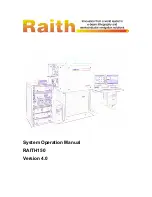
8
The load to be balanced must be hung on snap-hook (24) (Fig.4). Ensure that the snap-hook is closed correctly after having hung
the load.
The cable must never be fully unwound: the work travel must end at least 100 mm before it reaches the lower limit of the run.
ATTENTION: the electric potential of the hung tool must always be the same as that of the balancer.
If necessary, move and block the clamp (20) (Fig.4) to limit the upward run.
Do not unhook the load if the clamp (20) (Fig.4) does not lean onto the rope’s swaging (POSITION
SHOWN IN FIGURE 4).
- Do not leave the load if it is not in a vertical position;
- Do not swing/throw the hanging load to another operator;
- Do not move the load by pulling the balancer’s rope;
- Do not hang loads that are not within the upper and lower ranges of the admissible load-bearing capacity;
- Do not hang more than one tool on the balancer.
The highest risk linked to the use of the balancer consists in the uncontrolled rewinding of the
rope.
1 If, for any reason, the rope is not rewound by the balancer, DO NOT intervene and call immediately the maintenance service;
2 Never unhook the load if the rope is not completely wound in the drum, prevent the rope from touching the rope-guide.
3 Should you find the balancer with the rope completely unwound and no load attached, DO NOT intervene and call immediately
the maintenance service;
4 During use, the rope must be straight and must not be in contact with any pulley, ring or external structure close to the place where
the balancer is installed and used;
5 The use of the balancer is allowed only with its rope in a vertical position.
6 The adjustment of the balancer stroke must be done so to ensure the positioning of the tool at a height equal or lower to that of
the operator, notwithstanding the place where the balancer is installed.
7 Do not twist (beyond 360°) the rope during use, if the load must turn during operation then provide that the dedicated tool is used.
8 Should the balancer be provided with a locking device, use it when the tool hung to it is not used (end of work shift).
After the intervention of the devices that avoid the load fall or the uncontrolled rewinding of the
rope, a revision of the balancer is necessary. To this end, contact your dealer.
When the balancer is used with an electrical tool, please refer to the user manual of the electrical
tool for the management of eventual residual risks.
Do not use the balancer by holding it from the rope; hold only the snap-hook or the hanged tool.
c
hangIng
t
he
l
oad
/ c
hangIng
t
he
t
ool
Before proceeding with the tool change, it is necessary to rewind completely the balancer rope without using the stroke adjustment
device as a locking device.
Should the balancer be provided with locking devices, it is also possible to proceed as follows:
- Sustain the load in a different way (not through the balancer rope).
- Unhook the load from the balancer
- Hook the new load; bring it to a vertical position below the balancer with the rope stretched.
- Adjust the balancer, if needed, to balance the new load (when the new load has a different weight).
Do not move away from the balancer if a load is not hooked.
I
nspectIon
The balancer must be visually inspected on a regular basis (e.g. once at each work shift). Specifically, check the state of the
suspensions (A) and (S) (Fig.1a/b), the fixing screws and self-locking systems (if used), and the condition of the hooks and cable.
To check the cables, regarding rejection criteria (cable replacement), refer to ISO 4309:2011.
(See Fig.5 for some examples).
- check that the rope’s movement is smooth and that it does not make any strange noises;
- do not lubricate the balancer with flammable or volatile fluids;
- do not remove any labels. Replace any damaged labels;
- the balancer must be inspected at least once a year by skilled, authorized personnel.
In case of unusual behaviour of the balancer, contact your dealer.
t
ranslatIon
of
the
o
rIgInal
I
nstructIons
en
Summary of Contents for 9320AX
Page 34: ...34 ISO4309 2011 A B C 4 3 4 ...









































